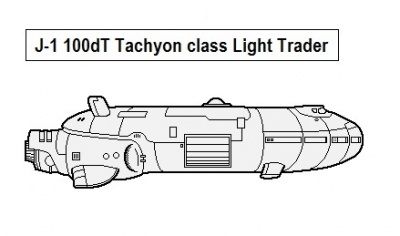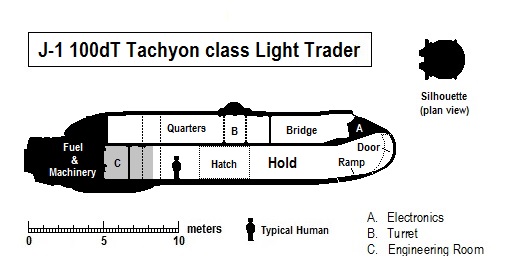Tachyon class Light Trader
| Tachyon class Light Trader | |
|---|---|
 | |
| Type: AF Free Trader | |
| Category | ACS |
| Size | 100 Tons |
| Hull Configuration | Flattened Sphere Hull |
| Streamlining | Airframe Hull |
| Tech Level | TL–9 |
| Engineering | |
| Computer | Model/1 |
| Jump | J-1 |
| Maneuver | 2 G |
| Armaments | |
| Hardpoints | 1 |
| Offensive | 1 triple turret w/ 2 missile launcher, 1 sandcaster |
| Accommodations | |
| Staterooms | 4 |
| Personnel | |
| Crew | 3 |
| Officers | 1 |
| Enlisted | 2 |
| High/Mid Passengers | 2 |
| Payload | |
| Cargo | 40 Tons |
| Fuel tank | 12 Tons |
| Carried craft | 1 4t air/raft |
| Construction | |
| Origin | Distant Fringe |
| Price | |
| Cost | MCr38.488 |
| Statistics | |
| Quick Ship Profile | AF-1A21 |
| Universal Ship Profile | AF–1611110–020000–00002-0 |
| Images | |
| Blueprint | No |
| Illustration | Yes |
| Source | |
| Canon | Unpublished, fan design |
| Designer | Ade Stewart |
| Design System | High Guard |
| Era | 1105 |
| Reference | Fan: Ade Stewart |
| Starships are designed with the Classic Traveller format, using High Guard Shipyard v1.13 written by Andrea Vallance. | |
The Tachyon class Light Trader is a TL–9 Merchant vessel.
- Please also see: Ships of the Distant Fringe
Description[edit]
The Tachyon-class Light Trader is a civilian vessel. It is a commercial transport typically encountered operating within clusters of stars within the Distant Fringe region. It is classified as a merchant vessel and is constructed as an X-Range design. Similar designs have been in use from the time the Distant Fringe was first settled.
Image Repository[edit]
- The flattened spheroid Tachyon class Light Trader, a rarely encountered design.

General Description & Deck Plans[edit]
The Tachyon class is an airframe flattened sphere with a mean diameter of 21 meters and a mean height of 5.5 meters, with paired lateral drive housings slightly increasing the overall length and the width of the stern (with their position indicated by a shaded area on the diagram below). The slightly irregular shape of the hull increases the overall internal space, giving the ship a total enclosed volume of approximately 1,350 cubic meters. There are two decks. The machinery and fuel tanks are located aft and operations are run from a small engineering control room. The lower deck is given over to the cargo hold: an area towards the rear of the hold, positioned below the accommodations section, is set aside as a vehicle hangar. The central section of the upper deck is given over to Staterooms and the turret mountings, while the bridge, computer and electronics are located forward.
- A common variant of the design is the Liz Zhorka class Light Trader.

A basic deck plan of the vessel indicating the general layout and positioning of major elements.
Basic Ship Characteristics[edit]
Following the Imperial Navy and IISS Universal Ship Profile and data, additional information is presented in the format shown here. The small craft factor indicates the number of squadrons (of ten subcraft) carried on the ship. Tonnage on the universal ship profile is shown in kilotons (thousands of tons) where necessary. [1]
| Basic Ship Characteristics [2] | ||
|---|---|---|
| No. | Category | Remarks |
| 1. | Tonnage / Hull | The Tachyon class is constructed using a 100 Ton hull built in a fattened sphere configuration. The hull is an airframe shape, giving good atmospheric performance that is further enhanced by airfoil surfaces and the vessels onboard gravitic systems.
|
| 2. | Crew | Total Crew Complement: 3
Accommodations
Accessible areas of the hull are fitted with grav plates and inertial compensators and have full life support and environmental systems.
|
| 3. | Performance / Engineering | The vessel mounts a DeVoss-type Jump-1 drive, a Maneuver-1 drive and a Power Plant-1, giving performance of Jump-1 and 1-G acceleration and producing 1 Energy Point. The ship has an agility rating of 1. The dedicated internal fuel tankage is sufficient for one jump-1 and gives the power plant 4 weeks duration.
|
| 4. | Main Section / Electronics | Adjacent to the bridge is a Model/1 Computer: the ship does not have a backup computer.
|
| 5. | Hardpoints | x1 hardpoint.
|
| 6. | Armament / Weaponry | The normal fit-out for a Tachyon class is a single mixed triple turret:
x2 Missile Racks, mounted as part of the mixed turret weapons array.
|
| 7. | Defenses | The hull is unarmored.
x1 Sandcaster rack, mounted as part of the mixed turret weapons array. The vessel is not fitted with screens or other passive defensive systems. |
| 8. | Craft / Subcraft | Vehicles
The hangar is a dedicated vehicle garage and forms part of the cargo hold. It is divided off by partition walls and also serves as a machine shop. The hanger has a total volume of 54 cubic meters. |
| 9. | Fuel Treatment | The vessel has internal fuel tankage of 11 dTons.
The ship carries a collapsible fuel tank with a capacity of 20 dTons: while stowed it uses 1 dTon of cargo space. |
| 10. | Cost | The basic cost of the vessel, complete with its Air/Raft, is MCr35.478. |
| 11. | Construction Time | 40 weeks (10 months) as standard.
|
| 12. | Remarks | Standard cargo capacity amounts to 40 dTons.
|
History & Background[edit]
The Tachyon-class is a small merchant designed to carry incidental consignments of cargo. The design is considered underpowered and suffers performance issues in high gravity environments. It is representative and a large number of variants exist, particularly with regard to the allotted weapons systems, onboard electronics, and the fit out of internal spaces. The current design dates to the Golden Age, but many elements are reused and aspects of the layout and construction indicate that the vessel has Vilani origins.
Tachyon class Traders are sometimes referred to as "puffers", a reference to small coastal watercraft serving isolated communities on pre-spaceflight Terra. The name has romantic connotations, implying personal freedom and a simpler way of life, but also reflects the rather claustrophobic conditions aboard those ancient trading vessels. The interior of the vessel is relatively cramped and the class are known for the substandard quality of their life support and environmental systems.
Class Naming Practice/s & Peculiarities[edit]
A number of companies manufacture ships equivalent to the Tachyon class. They vary in hull shape and internal layout but all share the same basic design and all have very similar capabilities and performance characteristics.
- Each variant class is named by the company that produces it: these organizations generally draw on traditional naming protocols. It is not uncommon for a historical class name to be reused.
- Individual vessels within a class are issued specific serial numbers and transponder codes but traditionally are named by their first crew. This is considered a serious affair and a ship with a frivolous name is considered "unlucky".
Selected Variant Types & Classes[edit]
56 Representative Free Trader (AF) Classes[edit]
A
- Akkigish class Far Trader
- Alexandria class Free Trader
- Anjou class Freighter
- Aoa'iw class Light Trader
- April Hare class Far Trader
- Athelstan class Merchant
- Avian class Far Trader
B
- Basil class Merchant
- Beowulf class Free Trader
- Bremen class Caravel
- Burning Sky class Merchant Schooner
C
- Caroline class Heavy Pinnace
- Ciigusna class Pinnace
- ColonyCord class Fast Trader
- Consul class Provincial Trader
- Coriander class Free Trader
E
F
G
H
I
J
K
L
M
N
P
R
S
- Salamander class Far Trader
- Sleeper class Fast Trader
- Soho class Light Freighter
- Stage class Far Trader
- Star class Armored Merchant
- Sundowner class Free Trader
T
- Tachyon class Light Trader
- Tequila class Free Trader
- Treader class Free Trader
- Trojan Reaches Type A3 class Trader
- Type Aj class Free Trader
- Type HR class Trader
U
V
W
References[edit]
| This article has metadata. |

|
This ship was originally designed using one of the Classic Traveller ship design rules:
|
- Author: Lord (Marquis) and Master Scout Emeritus Adie Alegoric Stewart of the IISS
- ↑ Timothy B. Brown. Fighting Ships (Game Designers Workshop, 1981), 10.
- ↑ Timothy B. Brown. Fighting Ships (Game Designers Workshop, 1981), 10.